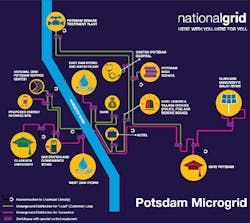National Grid to Test New Utility Microgrid Services
How will utilities make money as more customers generate their own electricity? That’s one of the big looming industry questions, and one that National Grid is trying to solve by testing new utility microgrid services.
The utility plans to try out the services in Potsdam, New York, where it is installing a microgrid with Clarkson University, General Electric and Nova Energy Specialists.
National Grid described the four services in a filing late last week before the New York Public Service Commission. The utility is exploring the idea within the state’s Reforming the Energy Vision (REV), a policy to decentralize the electric grid.
The utility sees the test as something that might benefit not only its own operation, but other utilities as they face a world where the old economic models no longer apply.
“With this REV demonstration project, National Grid aims to work with commercial customers, including private businesses, universities and municipal facilities to test community willingness to pay for increased resiliency, bringing 21st century solutions to combat the effects of 21st century storms,” the filing said.
The four utility microgrid services are: 1) underground microgrid wiring; 2) purchasing distributed energy on behalf of customers; 3) acting as a kind of grid operator for distributed energy; 4) handling microgrid billing.
While underground wiring is typically a utility activity, the other three services are not and could also be done by competitive players.
The utility will make its pricing for the services available and microgrid customers can either choose the utility or hire an independent company. If they choose a utility service, they will enter into a binding contract with National Grid for its delivery.
National Grid also plans to explore some novel rate structures. For example, the utility proposes recovering costs for underground wiring through a tiered structure with those who benefit the most paying the most.
The filing lists several types of “critical load” customers in Potsdam that might benefit from the new services, such as colleges, police and fire, wastewater and water treatment plants, a hospital, a bank and others.
The utility also is hopeful that residential customers will be willing to pay part of the cost of the microgrid when they see that it assures more access to medical, safety, banking and other services during an outage. Potsdam has experienced prolonged outages from summer microbursts and winter ice storms.
National Grid is still developing details on the utility microgrid services. The utility expects to make more information and pricing available under the following schedule:
- June 2016: The microgrid’s conceptual design will be finished and costs available on underground wiring, distributed energy, the controller and other aspects of the project.
- November 2016: National Grid will release its preliminary pricing for utility microgrid services. Potsdam microgrid customers will be able to compare the utility pricing and services to any offered by independent companies.
- June 2017: Customers would make a Go/No Go determination on the utility microgrid services.
Interested in learning more about how a microgrid might serve your business or community? Attend the Microgrid Knowledge May 19 conference in Manhattan.
About the Author
Elisa Wood
Editor-in-Chief
Elisa Wood is the editor and founder of EnergyChangemakers.com. She is co-founder and former editor of Microgrid Knowledge.
